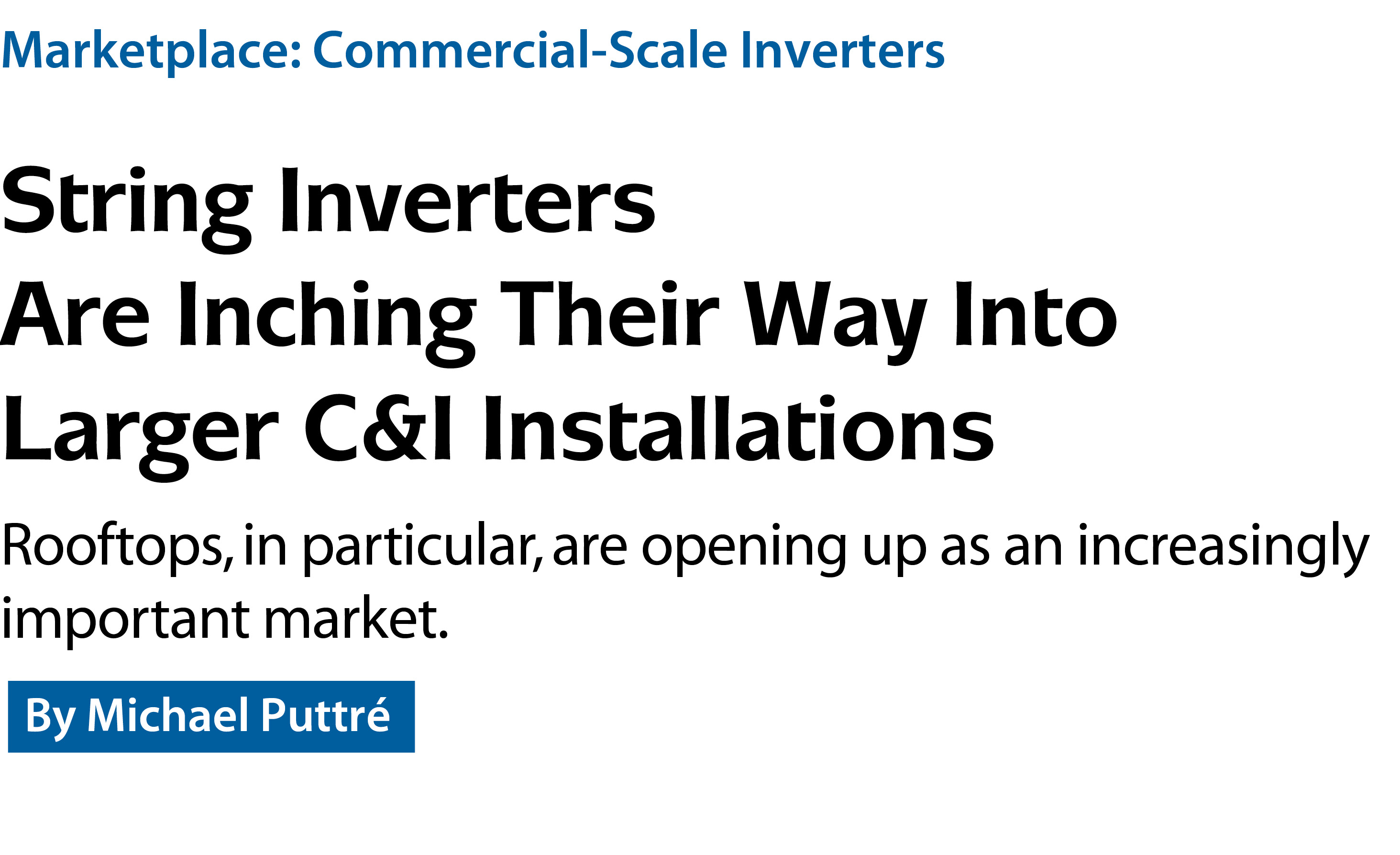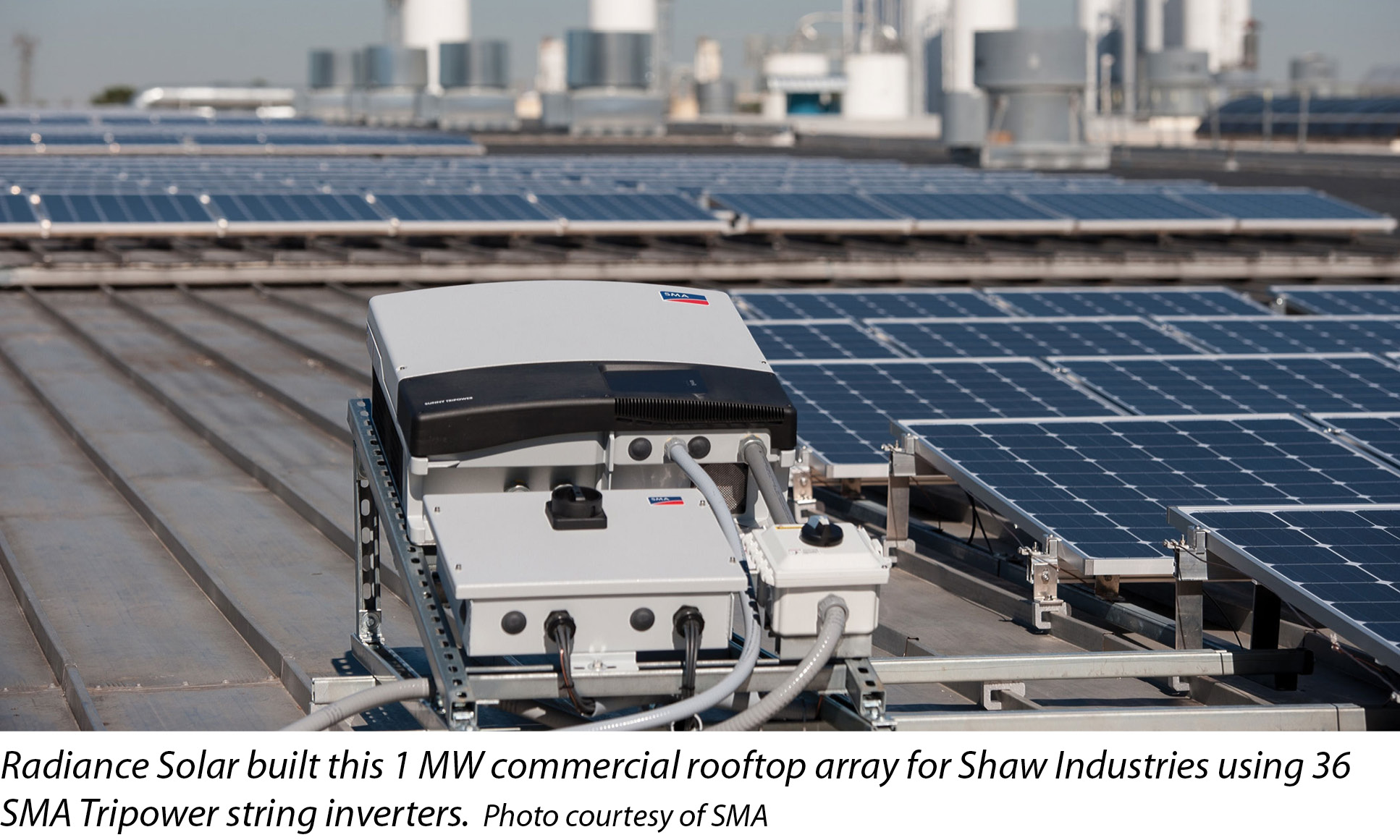

301 Moved Permanently
While the solar sector in the U.S. continues to be dominated by utility installations in terms of capacity and residential in terms of numbers, there are indications the commercial and industrial (C&I) segment may be ready for its close-up.
As the financing in this market becomes more attractive, particularly for large rooftop installations, developers are becoming more successful at making the pitch to prospective customers. Last year saw a number of megawatt-scale commercial rooftops, and more are in the works. Manufacturers of three-phase string inverters are stepping up to be part of those plans.
“In 2014, C&I market growth was relatively weak compared to residential and utility,” says Natalie Holtgrefe, senior marketing manager at Solectria. “However, we are optimistic that rapid growth will resume in 2015 and 2016 for a variety of reasons, including the slowdown in large utility-scale project development, the impending reduction of the federal investment tax credit, and the broadening of state incentives for distributed generation. Activity from large nationwide developers is making a difference, by streamlining and standardizing project development and financing solutions.”
Brad Dore, director of marketing for SMA America, says the C&I space has seen a lot of development over the last couple of years, as well as some changes in how technology is employed in that market.
“Take a look back at where the C&I space was a couple of years ago versus where it is today,” Dore says. “A couple of years ago, it was dominated by central inverters - 150 kW, 250 kW, 500 kW. What we’ve seen over the last couple of years is the introduction of three-phase string inverters into the C&I space, many times from companies that had specialized in central inverters. We’ve seen a rapid adoption of that model onto the commercial rooftop.”

Getting it right
What, then, is the appropriate, right-size strategy? The answer depends very much on the site and the background of the developer. Companies approaching C&I rooftop development from a strong portfolio of ground-mount commercial and utility projects may find central inverters perfectly suited to their needs.
“There can be a number of advantages to using string inverters for rooftop C&I applications,” Holtgrefe says. “String-level optimization often yields higher power production, especially where there is shading or differences in module orientation across the array. There are also potential benefits in reducing upfront inverter and BOS costs, especially at 1,000 V, depending on the array size and layout. This increase in power production, combined with lower cost, results in improved LCOE.”
Dore describes a sweet spot for C&I string inverters in the 20 kW to 25 kW range in that the developer can take a building-block approach. For example, a 250 kW system on a rooftop can be designed in blocks of 25 kW.
“This architecture results in a very manageable system that can be serviced effectively,” Dore says. “If one string goes out, you can localize that very quickly. I would call this a right-sized installation.”
Nevertheless, most are in agreement that at some point, a centralized inverter architecture generally offers a better cost per watt. Also, as the installations become larger, a more sophisticated approach to operations and maintenance (O&M) is required. Firms with such experience are likely to have a background in larger installations and significant experience with central inverters.
Mike Mahon, a technical trainer at SMA’s Solar Academy, says that if installers are already familiar with the company’s residential string inverters, it is not a tremendous leap for them to become comfortable with the C&I version.
“The Sunny Tripower is pretty much 95 percent the same,” Mahon says, comparing the company’s commercial string inverter to its residential offering. “So the installers already have a high degree of comfort with that product, and not much training is required to make them feel ready to use that in a commercial setting. It’s a relatively easy sell compared to what might be a daunting prospect trying to maintain a central inverter.”
Dore says the long-term O&M strategy may be simplified through the use of string inverters in the appropriate C&I installations. It also opens up business opportunities for integrators who may not have the capabilities to service central inverters. “Strings are a little less labor-intensive in terms of the amount of active management you need,” he says.
On the other hand, the number of expected failures is greater when using string inverters, simply because there are more of them per installation. The frequency of scheduled repairs or replacement and related costs and lost production need to be considered when devising the O&M plan.
“The jury is still out on whether O&M costs for string inverters are significantly lower than Solectria’s central inverters for C&I applications,” Holtgrefe says. “Installers should carefully weigh the costs of string versus central for their particular application and O&M strategy.”
Dore agrees that if you push down too far, and you start getting smaller, the added upfront cost negates any long-term savings you are going to get from O&M.
“In fact, you actually end up having the opposite effect as you integrate too many inverters into a system,” he says. “You increase your points of failure to a degree that your O&M provider is constantly moving from row to row replacing inverters.”
Building credibility
Solectria’s Holtgrefe points out that string inverters are already well designed for C&I projects and have quickly been adopted by the majority of installers for rooftop and carport applications, and even for smaller ground-mount systems. Using string inverters can simplify compliance with NEC 2014 code changes affecting PV systems, such as rapid shutdown and arc fault detection.
She points out that her company’s string inverters have been specified in a wide variety of C&I projects in North America, from Walmart stores to carports to community solar arrays. One example of a large C&I installation employing string inverters is the 1.1 MW array at the Bausch & Lomb manufacturing plant in Rochester, N.Y., which has a combination of Solectria’s PVI 23TL and PVI 28TL string inverters. While the Bausch & Lomb array is a ground-mount, it does underscore how string inverters may be scaled up for installations that once would have required a central inverter.
SMA’s Dore says the company has integrators that regularly use 1 MW blocks. In 2013, Radiance Solar completed a 1 MW commercial rooftop installation featuring 36 SMA Tripower inverters at Shaw Industries’ carpet tile manufacturing plant in Cartersville, Ga. One of the largest systems using string inverters is a 24 MW system using Tripowers in Honduras. It’s not rooftop, Dore concedes, but it demonstrates the scalability of the block architecture.
The flexibility of string inverters should enable string inverters to compete in the burgeoning C&I market, particularly in rooftop settings.
“New technologies will continue to be developed to comply with new or evolving standards - such as California’s Rule 21 for smart inverters - and to improve overall performance of string inverters for various C&I applications,” Holtgrefe says. “We’ve also seen a number of third-party products introduced in the past year to enhance performance - specialized racking systems and shading structures, for example.”
Marketplace: Commercial-Scale Inverters
String Inverters Are Inching Their Way Into Larger C&I Installations
By Michael Puttré
Rooftops, in particular, are opening up as an increasingly important market.
si body si body i si body bi si body b
si depbio
- si bullets
si sh
si subhead
pullquote
si first graph
si sh no rule
si last graph